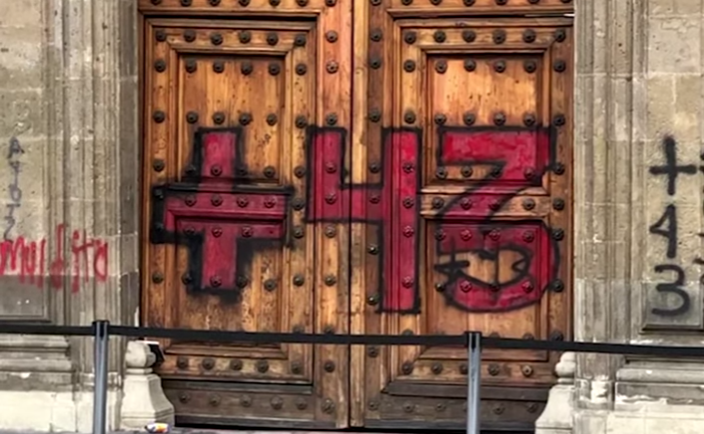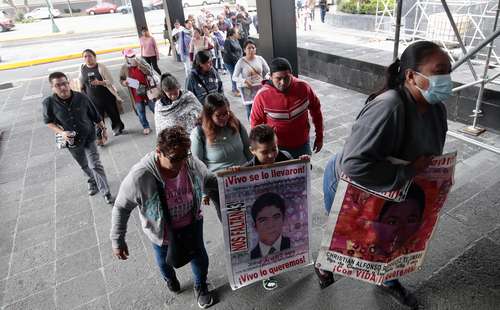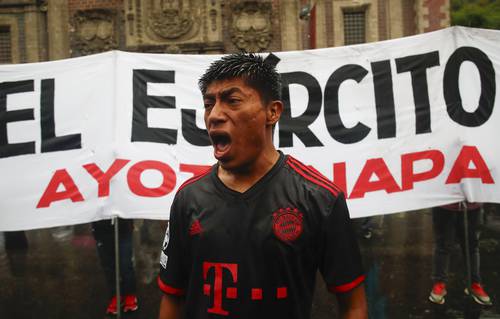
Mariana Mora*
In her essay, “The Origins of Totalitarianism,” published in 1951, the German philosopher Hanna Arendt develops elements that allow us to understand the exercise of power of totalitarian states and forms of totalitarian organization that exist under other regimes. One refers to how governments manage to exercise their power through the calculated and systematic repetition of information to the point of fabricating truths, which in turn allows that regime to remain in power. Arendt establishes that political lies may require a rearrangement of the fabric of facts, which implies creating another reality so that the lie can be accommodated. It is not just a matter of public officials issuing false statements, but of a scaffolding that over time acquires the consistency of an ostensibly firm and stable reality.
Unraveling a fabricated reality so that the lies it accommodates collapse under their own weight has been one of the most relevant achievements of the Interdisciplinary Group of Independent Experts (GIEI). Since its arrival in Mexico in November 2014, as part of a technical assistance agreement of the Inter-American Commission on Human Rights with the Mexican State and the legal representatives of the missing students of Ayotzinapa, until July 31 of this year, when its activities conclude, the GIEI has been systematically dedicated to finding the threads that cover up the truth and painstakingly pulling at them to get closer to the whereabouts of the normalistas. They managed to dismantle the so-called historical lie, the official version of the incineration of the youths in the Cocula garbage dump. They played a key role in the arrest of former Attorney General Jesús Murillo Karam, members of the Army, among others. They demonstrated conclusively that the armed forces are part of the network of actors shielded by the impunity of the events.
The presentation of its sixth and final report was held on July 25 with the participation of Angela Buitrago and Carlos Beristáin, the two remaining members of the GIEI from the original five, including Claudia Paz, Francisco Cox and Alejandro Valencia. Beristáin pointed to the kind of fabricated reality, constructed over the years, that allowed so many state lies to fit in. He referred to the counterinsurgent vision that the armed forces have maintained towards the students of the Ayotzinapa normal school. Despite the lack of evidence that the youths were involved with criminal networks, state agents insist that they are delinquents and troublemakers. This approach to the normalistas’ activities not only creates a negative image that hurts the family members, but has been key to the events taking place.
There is compelling documentation of the level of collusion between organized crime and the authorities. There is also new evidence of the involvement of the armed forces. By analyzing the movement of cell phones, they showed that several members of the armed forces were at the scene. That night there was constant communication between them and other actors. In contrast to what the Army has said for almost nine years, not only did they know what was happening in real time, but they were present where they had denied being.
Buitrago referred to at least 200 people from six corporations who have participated in the falsification of arrests, including registration by one institution when they were actually carried out by another, others that were not carried out by that agency, and basic information that is false, including erroneous dates. He also referred to officials who claim to have been in one place when documents show that they were in a different place. He concluded: I do not know if the institutions are uncontrolled or controlled, but I can say, and the investigation shows it, that the control across the sectors was absolute in order to maintain a version in place.
This is the modus operandi of the State apparatus, it is not only due to institutional inertia, nor is it limited to certain administrations. Beristáin insisted on that point: Ayotzinapa touches on structural aspects of the functioning of the Mexican State. Reaching the truth of the forced disappearance of the 43 is a lever for profound change. Knowing the whereabouts of the normalistas implies that this control of lies does not have to be the curse of our society.
The counterweight that seeks the truth is now left without the GIEI. It has reached the limit of what it can evidence because the information it has requested has been denied. That hurts, it provokes a kind of vertigo.
What additional roles correspond to those of us who have fought alongside the relatives and their legal representatives? How do we continue to cultivate the terrain of justice based on the truths expressed by the relatives of the 43? What additional pressures do we have to develop so that the Army will hand over the information that exists? The answers, as Buitrago reminded us, will give substance to justice, to that collective impulse capable of accommodating and giving order to another type of society.
* Professor and researcher at Ciesas
Originally published in La Jornada on July 28th, 2023. https://www.jornada.com.mx/2023/07/28/opinion/020a2pol
English translation by Schools for Chiapas.
Sedena and Navy hide information vital to finding the 43: GIEI
There is a risk that lies will be institutionalized as a response; this is unacceptable, they say.
Blanche Petrich y Jessica Xantomila

Several batches of documentation from the Secretariat of National Defense (Sedena) and the Secretariat of the Navy (Semar) that contain “vital and fundamental” information to find the whereabouts of at least some of the missing normalistas, have been withheld from the Interdisciplinary Group of Independent Experts (GIEI), after eight requests made in the last year of their work on the Ayotzinapa case.
These repeated “cover-ups, refusals and lies” on the part of the military authorities make it “impossible to continue with our work,” explained yesterday one of the experts, Carlos Beristain. “We have reached the limit of what can be done.”
With these words and an emotional “thank you moms and dads,” which made the criminal lawyer Ángela Buitrago’s voice break, the last two members of the GIEI who remained, despite the multiple crises and storms, presented their sixth and last report in the auditorium of the Tlatelolco Cultural Center, which was filled to capacity.
In the front rows, many of them occupied by mothers of the missing boys, some of them already aged and yet at the foot of the cannon, had reached for their reserves of handkerchiefs. They were prepared for this farewell. The experts had already talked with them at length. Blanca, one of the mothers, asked them: “Before you leave, tell everything you know; don’t keep anything to yourselves.”
In this last report, the GIEI revealed that there is another pool of data that until now has been kept secret by the Naval Intelligence Unit, and that the participation of the marines in the cover-up, concealment and deflection of the investigations and in the construction of what former Attorney General Jesús Murillo Karam called the “historical truth” has remained hidden.
Semar, Cisen, police: all of them were there and lied
Investigators received just five days ago, in time to be able to include it in the report, a piece of information. It reveals that the Navy’s Naval Intelligence Unit operated at the Cocula landfill and on the banks of the San Juan River on October 27, 2014, to fabricate the false crime scene at the landfill and, two days later, the discovery in the riverbed of a plastic bag with supposed remains. The director of the Criminal Investigation Agency, Tomás Zerón, now a fugitive in Israel, was there.
According to the report, the Navy installed a detachment in Coatepec de los Costales, municipality of Teloloapan, where there should be monitoring and information on the fate of the boys. In addition, the investigators corroborated, including with photos, that the marines participated in the arrest and torture of the alleged culprits, members of Guerreros Unidos, and that at least two people were killed in those actions.
The latest report, as extensive as the previous five, of more than 300 pages, contains other news about the presence of members of the then Center for Investigation and National Security (Cisen), the Federal Police and the ministerial police in the pursuit of the students in Iguala, a circumstance that these agencies denied all the time. There is an arrest warrant against one Cisen agent.
The experts were able to determine that the now imprisoned General Jose Rodriguez Perez, then a colonel, was constantly moving in those places, as reflected in the geolocation data of his cell phone. The high-ranking officer, who was commander of the 27th Infantry Battalion, had claimed that he did not leave his barracks that night.
At the end of an intense session, in which both experts expressed feeling emotional and also frustrated, a student from the Isidro Burgos Rural Normal School spoke on behalf of the parents of the 43 disappeared, their classmates and the collectives that are searching for their loved ones, to warn that this movement has not lost strength, because knowing that we have enough evidence to find the whereabouts of our comrades, but that they do not want to move forward, gives us the necessary strength to continue.
The student also reminded President Andrés Manuel López Obrador that “he has one year left to fulfill the promise he made to us of a solution,” and that by September of next year, 10 years after the night of Iguala, there will be another president elected in the country.
On this point, the two experts responded that they are hopeful that, even without the GIEI, the investigation will continue, deepen and overcome the obstacles and lies that currently plague it. “We will not give up,” said Angela Buitrago, but Beristain added: “There is a risk that lies will be institutionalized as a response. This is unacceptable.”
Carlos Beristain pointed out that the Ayotzinapa Case is “a lever for change in Mexico, it can be an opportunity” to overcome the weight of impunity that still prevails over forced disappearance. “Our reports are a tool to continue.”
The experts announced that today they will meet with the Commission for Truth and Access to Justice of the Ayotzinapa Case (Covaj), which is headed by the Undersecretary of Human Rights, Alejandro Encinas, and in which the fathers and mothers of the 43 students will also be present.
Movements by Semar and Sedena
During its investigation, the GIEI had meetings with the Secretary of the Navy, José Rafael Ojeda, and other high-ranking officials, who maintained that the presence of the Navy in the San Juan River investigation was only to secure the perimeter of the area and the work of the divers.
Today it is known that this is false. The GIEI detected evidence of secret operations by the Naval Intelligence Unit, including drone flyovers, in the vicinity of the San Juan River on September 27 and 28, to prepare for the “discovery” the following day.
The investigators also determined that it was marines, not the then Attorney General’s Office, as it was claimed, who illegally detained several alleged perpetrators, took them to naval centers and tortured them.
Semar directed and carried out actions in Chilpancingo, Pueblo Viejo, Iguala, Iguala-Teleolapan stretch, Loma de Coyotes, Coatepec de Costales and other sites that have been mentioned by different informants as possible whereabouts of the missing youths. To the GIEI’s requests for information, the Navy responds that it “does not exist.”
The GIEI obtained 16 transcripts of messages and phone calls intercepted by military intelligence and that are concentrated in the Regional Intelligence Fusion Center, based in Iguala, which Sedena still maintains does not exist.
In these transcriptions of the critical dates of the events, one can read conversations from members of organized crime about “the detainees of yesterday’s shitshow,” of “the 11 that touched you,” of “those who were detained here in Chilpo.” And one of them comments about “the poor parents and how they are doing (sic).” There is talk that “they have 17 in a cave”; that there is pressure to “release some of them.”
These messages contain clues to locate the places where the 43 disappeared were taken, such as Pueblo Viejo and Loma de Coyotes. For seven years this information was hidden. And even today, with solid evidence of their existence, Sedena maintains that “they do not exist,” that the recorded conversations are not transcribed, that they have nothing else.
Original article published in La Jornada on July 26th, 2023. https://www.jornada.com.mx/2023/07/26/politica/005n1pol
English translation by Schools for Chiapas.
Parents of the 43 demand urgent meeting with López Obrador
After report and departure of the GIEI, they say they feel deeply hurt.
Jessica Xantomila

The fathers and mothers of the 43 Ayotzinapa normalistas who disappeared in 2014 demanded yesterday an urgent meeting with President Andrés Manuel López Obrador, after the Interdisciplinary Group of Independent Experts (GIEI), in its last report, evidenced the “cover-ups, refusals and lies” of the Army and the Navy to deliver vital and fundamental information for the case.
Mario Gonzalez, Cristina Bautista and Emiliano Navarrete expressed, on behalf of the students’ relatives, that they are deeply hurt by the departure of the GIEI, because there are no conditions for it to continue its work in view of the armed forces’ refusal to release the information they have.
In a conference, they emphasized that for them the only valid document with the lines to follow in the investigation is the report of the GIEI, in which, as key points, are the routes by which the missing students could have been taken.
“We feel very sad, angry and worried about not reaching the truth,”mentioned Bautista, mother of Benjamin Asencio.
They insisted that it is urgent that the chief executive receive them to lay on the table that which are the real obstacles in the investigation, and that he enforce the 2018 presidential decree, which orders the armed forces and institutions to hand over all the documentation they have on the case.
In the auditorium of the Miguel Agustín Pro Juárez Human Rights Center (Centro Prodh), González, father of César Manuel, considered that the president “is failing” to keep his word. “We do not deserve it for what we have done and fought for, for what we have suffered and been deprived of. Enough of such closed-mindedness!”
Rough meeting with Encinas
The relatives indicated that both the information from the GIEI and their demands were presented yesterday to the president of the Commission for Truth and Access to Justice in the Ayotzinapa Case (Covaj), Alejandro Encinas, Undersecretary of Human Rights of the Interior.
They acknowledged that the meeting was acrimonious; although they have not broken off work with the Covaj, they clarified that “their position is that we cannot continue to dialogue with other authorities” if there is no meeting with President López Obrador, commander-in-chief of the armed forces.
Encinas “says that they will follow up on the GIEI report, but insists that there are no divergences with their work. Obviously we have points of disagreement there, which were brought to the table,” explained Vidulfo Rosales, a lawyer for the mothers and fathers.
Santiago Aguirre, director of Centro Prodh, pointed out that the case is at a delicate moment. He recalled that in 2018 there were three pillars: the return of the GIEI, the Covaj and the special prosecutor. Now the experts are gone and there is no head of the Special Investigation and Litigation Unit for the Ayotzinapa Case that they trust.
He added that the accompanying organizations do not have a political agenda: “we are human rights defenders.”
Miguel Álvarez, from Serapaz, highlighted that the GIEI report presented two important keys to follow: that there was participation of the Army in the events and that the counterinsurgent approach to the young people should be analyzed.
The latter, he said, opens up many questions. For example: “Who used whom? Did organized crime use people from the Army because of corruption? Or did the Army use organized crime for counterinsurgency reasons?”
The day concluded with the monthly march of fathers and mothers of the 43 students eight years and 10 months after the disappearance of the young people. In the mobilization, which left from the Angel of Independence to the Hemiciclo a Juarez, they reaffirmed that they will continue their struggle. “The case is not going to remain in impunity, we will continue.”
Originally published in La Jornada on July 27th, 2023. https://www.jornada.com.mx/2023/07/27/politica/012n1pol
English translation by Schools for Chiapas.
